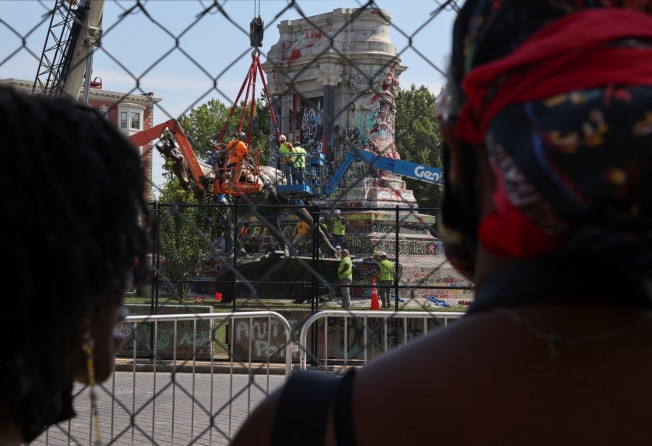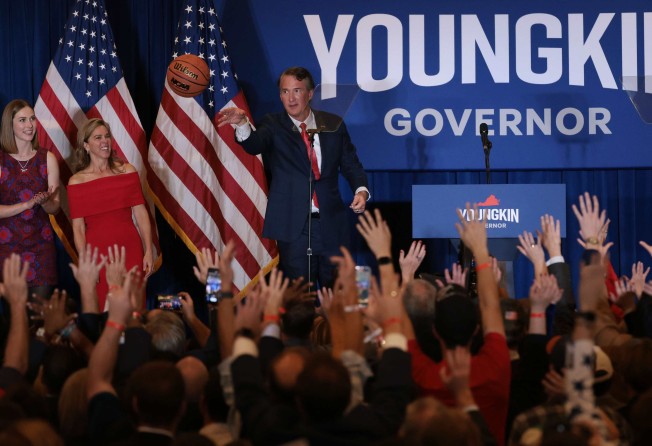
How the Virginia election highlights the extent of US racial divisions
- One of the factors in Republican Glenn Youngkin’s victory in the gubernatorial election was his attack on critical race theory
- That this strategy worked will embolden Republicans to push hard against attempts to draw attention to inequality and embrace inclusion

The US state of Virginia has a new governor-in-waiting, and the world has a better understanding of the extent of America’s racial divisions.
Many Democrats had watched hopefully as the state’s northeastern region grew more integrated with Washington DC, where Black Lives Matter banners abound and Republican presidential candidates are lucky if they manage to pull more than 9 per cent of the vote.
Ever-present heat in the housing market drove the median sale price for single-family homes in the US capital above US$1 million for the first time last year.
This has pushed more of Washington’s residents over the Potomac River, to create a wide swathe of suburbs and satellite towns populated by ideological progressives, the federal government bureaucracy, (aka “the deep state”), and other moderates generally not inclined towards scorched earth politics.
It’s a shift that should help turn the “purple” state of Virginia more reliably blue – but for the ferocity with which Republicans have played the race card, not to mention their barrage of misinformation about vaccines, the 2020 election, and the extent to which Harry Styles’ gender nonconforming outfits are undermining America’s youth.

The US media hyped coverage of the Virginia gubernatorial election in the run-up to Republican Glenn Youngkin’s victory as if it were a presidential poll.
But the only analysis needed to figure out who would win was to consider that the course Trump set for the Republican Party has only gained momentum since the January 6 insurrection. Even with Youngkin trying to distance himself from Donald Trump, his messaging was straight from MAGA-land.
An evangelical Christian, Youngkin railed against the teaching of critical race theory – a framework for understanding how racial bias is embedded in legal and other systems and policies – in Virginia’s public school system.
As with other fallacies pro-Trump Republicans have pushed – like how the Mexican government would fund a border wall and Chinese companies would pay the punitive import tariffs that the former president slapped on goods from the country – this was something that never happened.
Virginian parents were outraged even though critical race theory was never on any Virginia public school curriculum. Conservative media outlets have “revealed” references to critical race theory in documentation by the state’s education department as a framework for understanding racism, as though this were the equivalent of Watergate.
Banning critical race theory from discussion among educators is like saying school boards should never bring the ideas of Simone de Beauvoir into a discussion about how to encourage girls to excel in maths and science.
What’s lost in this particular conflict is the strategic win by the Republicans that goes beyond Virginia’s governorship: the inclusion in public schools of the objective facts about slavery in America followed by decades of lynchings, segregation and the practice of “redlining” – the government’s practice of rating neighbourhoods in a way that enabled banks to deny home loans to Black families – will be seen as corrosive.
The Democrats are no angels when it comes to race. They did very little for the black community for decades. Since the civil rights legislation that then-president Lyndon Johnson pushed through in the 1960s, the Democrats ignored the widening wealth gap between most white Americans and the black community, all the while assuming African-Americans would support them at the polls.
But now, with the American electorate more divided than ever about anything that’s not related to China, we’ve seen Republican election strategies undercut any hope for less racial friction.
A recent message sent around by the conservative Heritage Foundation encapsulates the new thinking around the issue, part of the devastating efficacy of Republicans in devising policies to push back against their greatest threat: an increasingly multi-ethnic electorate.
“Race theorists are really good at disguising their indoctrination,” according to a pitch by the think tank for a new publication they’ve assembled in the fight against critical race theory. “They use words like ‘diversity,’ ‘equity,’ and ‘inclusion’ because those words sound harmless.”
Harmless shouldn’t be the descriptor we use for these words. For the growing communities of people who don’t fit into the plot of an American sitcom from the 1950s, these words are hopeful.
A generation of Americans has come of age learning that inclusion made all our lives better. Youngkin’s victory ensures that the new Republican Party is out to kill this idea.
Robert Delaney is the Post’s North America bureau chief